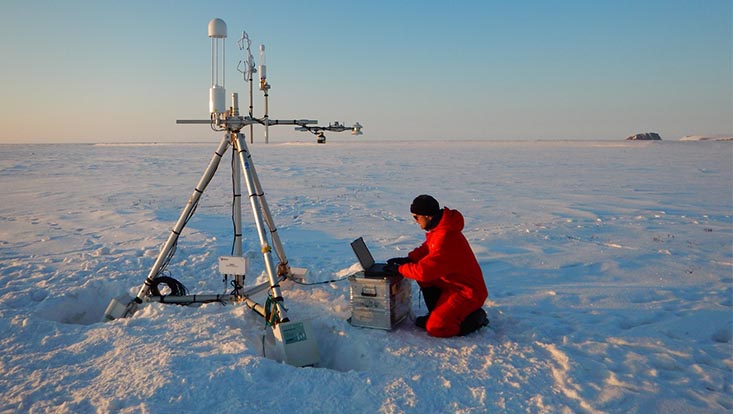The Breath of the Tundra
10 January 2019, by Dr Norman Rößger CEN Universität Hamburg

Photo: N. Rößger
In northern Siberia, the effects of climate change can already be seen with the naked eye: previously frozen soils are now thawing, houses and railroad tracks are sinking into the mud, and coasts are being washed away. Because temperatures are rising twice as fast as the global average in the Arctic, the region is far more prominently affected by global warming. At the same time, its own warming is likely to have massive effects on the global climate.

The most problematic aspect: the large quantities of carbon that are stored in the soil, in the form of dead organic material. When temperatures rise, this material begins to thaw, and microorganisms in the soil begin breaking it down. In the process, they produce carbon dioxide and methane: but how much of these climate-harmful greenhouse gases are released is something we can currently only guess.

Together with my colleagues at Universität Hamburg’s Center for Earth System Research and Sustainability (CEN), I’m working to gain a better understanding of the processes active in the soils of the tundra. In this regard, I’ve also joined several expeditions to Siberia. On one of the 1,500 islands in the Lena Delta, 650 kilometers north of the Arctic Circle, I took readings of how much methane the soil is releasing.
Researchers need this type of observational data, e.g. to create climate forecasts with the aid of computer models. Yet we still have very little data from Siberia; simply because it’s so huge, and at the same time so inaccessible. There are no roads or cities, and also research stations are a rare sight. The resultant lack of data limits the accuracy of climate forecasts.
In order to obtain additional data, I took my readings in an ecosystem that had never been investigated before: the floodplain of Samoylov Island. To do so, I set up a 2.5-meter-tall “tower” bristling with measuring equipment, which I had to dismantle again before the spring floods that come in May. I was only able to set it up again once the meltwater from the Lena’s catchment, which is seven times the size of Germany, had found its way to the Arctic Ocean.
All the while the tower was in operation, its systems measured turbulences in and the methane concentration of the air, twenty times every second. Using the results, I was able to calculate the methane emissions from the soil. What’s more: I was able to filter the data to determine how much methane each vegetation zone on the floodplain contributed. After all, zones characterized by bushes and shrubs put out different emissions levels than those dominated by grass and moss.

Using the method I developed here, other researchers will now be able to distinguish between emissions produced by different types of landscape, and more reliably estimate how much methane each type puts out. In contrast, if the landscape diversity typical of the tundra isn’t taken into account, the methane emissions can be significantly underestimated or overestimated – on Samoylov, for example, this would produce a discrepancy of ca. 40 percent.
Accordingly, my work can help improve the accuracy of climate models; yet it does nothing to change the global problem of climate change. For me, it is sobering to see how rapidly the Arctic is changing, and how little is being done at the political level in Germany to protect our climate. We still have a chance to limit the effects of global warming – but only if we take far more meaningful steps than we have in the past. If we do, future generations will thank us for it.
Dr Norman Rößger completed his doctoral studies at Universität Hamburg’s Institute of Soil Science and is a member of the Center for Earth System Research and Sustainability.
This article was first published as a guest article in the Hamburger Abendblatt as part of a monthly series on climate research. Here you can find more articles of the series.


